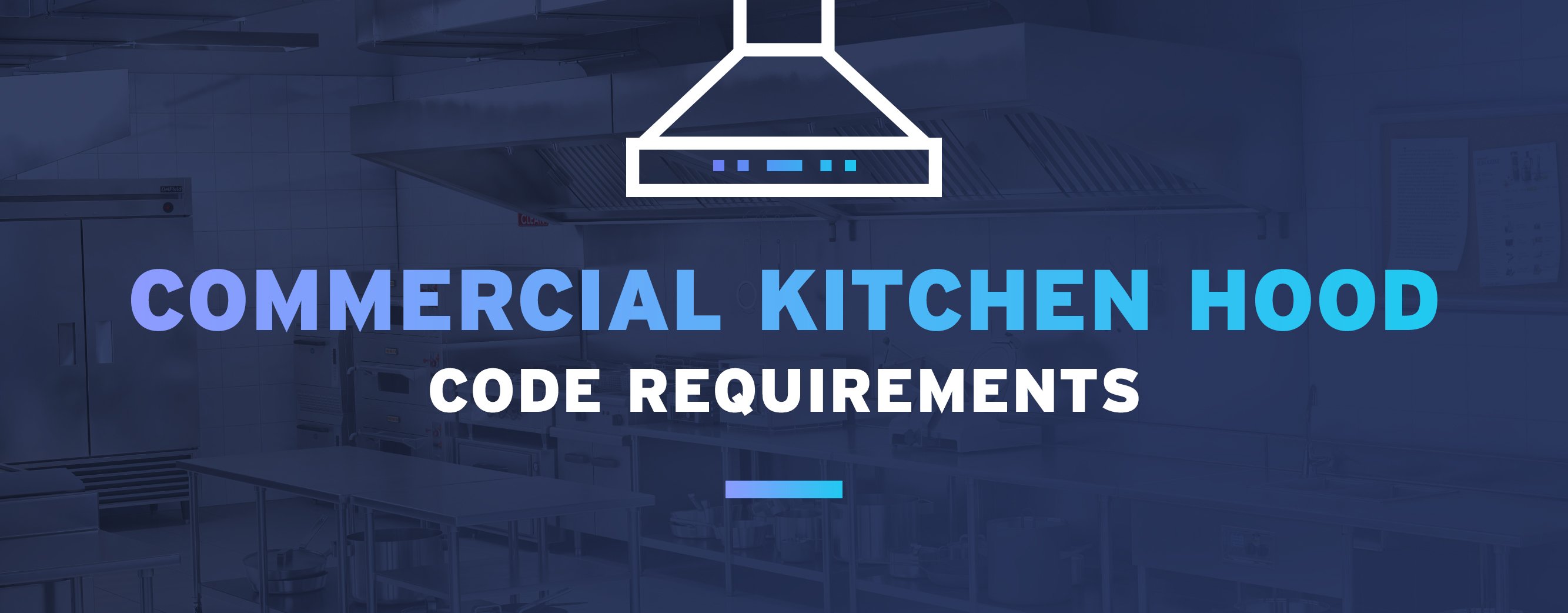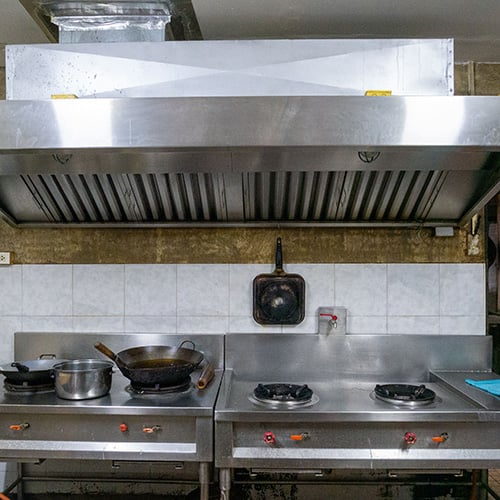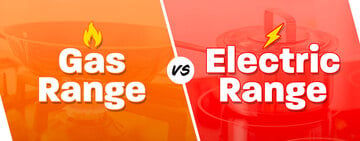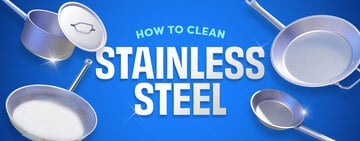
Each kitchen must comply with regulations and standards to function within the law. Regarding kitchen ventilation systems and related equipment, adherence to these guidelines is crucial in preventing potential dangers and upholding air quality in a professional environment. Use this guide to explore the purpose of kitchen hoods, their functionality, and the specific code requirements that you should follow to ensure a safe work environment.
What Is a Kitchen Hood?

A kitchen hood is a device installed above a cooking surface or cooking appliance that helps ventilate the kitchen. Also known as range hoods or exhaust hoods, they remove hazardous particles from the air and maintain a safe working environment. They also maintain the air quality of your kitchen and help to reduce the buildup of smoke, grease, and other similar particles, simplifying cleaning and maintenance for your staff.
How Do Kitchen Hoods Work?
Kitchen hoods sit above your cooking appliances. A fan powered by a motor spins as you cook, pulling air and any hazardous particles into the machine. The air travels through ductwork attached to the machine and is displaced outside. Kitchen hoods should be outfitted with a make-up air device to replace any air filtered out of the building. As you check that your ventilation system is up to code, stock up on ventilation and range hood parts to make necessary adjustments.
Types of Kitchen Hoods
There are two types of commercial kitchen hoods: Type I and Type II hoods. Each hood filters different types of materials out of the air.
- Type I Hoods: Also known as grease hoods, Type I hoods remove heat, smoke, and airborne grease. These hoods are found over appliances such as fryers, broilers, grills, and ovens.
- Type II Hoods: Sometimes called condensate hoods, Type II hoods work to remove steam, vapor, and other moisture from the air. Some Type II hoods even remove odors. They are often found on coffee machines, commercial dishwashers, and certain pizza ovens. However, these types of hoods lack a grease filter, so do not use them interchangeably with Type I hoods.
To legally operate your kitchen, you must adhere to local commercial kitchen hood code requirements for each type of kitchen hood. While most states and municipalities follow the International Mechanical Code as the basis for their regulations, certain specifications and code requirements can vary depending on where you live. Before deciding how to establish your exhaust system, check with local officials.
Kitchen Hood Design and Layout Specifications
When planning your kitchen, you should consider regulations regarding the layout, construction, and design of your kitchen's exhaust system. Failure to do so can result in safety hazards, failed inspections, and costly renovations. To properly install your equipment, keep the following requirements in mind:
- Meet the minimum overhang requirement: The inside lower edge of commercial hoods should overhang or extend no less than 6 inches beyond the edge of the cooking surface or appliance below it.
- Stay within the elevation range: The vertical distance above the cooking surface should not exceed 4 feet.
- Install fire suppression systems: All commercial appliances under a Type I hood are required to have an approved automatic fire suppression system. This system should comply with the International Building Code and International Fire Code.
- Use the proper equipment: Do not use hoods intended for use above extra heavy-duty equipment above heavy, medium, and light-duty equipment.
Type I Hood Requirements
Due to the significant differences between Type I and Type II hoods, each type is subject to unique rules and regulations. Since Type I hoods collect flammable materials, they should be constructed, designed, and laid out specifically in your kitchen. Below, we’ll investigate the requirements for Type I hoods:
- Avoid combustibles: Install your hood at least 18 inches away from combustibles.
- Use approved materials: Any hood in the kitchen should be made of steel with a minimum thickness of 0.0466 inches or stainless steel with a minimum thickness of 0.0335 inches.
- Label your hood: Each hood should include a label indicating the minimum exhaust flow rate in CFM (cubic feet per minute) per linear foot.
- Construct appropriate support: Check that each hood is secured in place by noncombustible supports.
- Protect joints, seams, and penetrations: Any external joints, seams, and penetrations should be made from continuous external liquid-tight weld or braze to the lowest outermost perimeter of the hood.
- Keep joints sealed: Internal joints are not required to be welded or brazed but should be sealed so grease cannot escape.
Elevation Requirements for Type I Hoods
Outfit all Type I hoods with a grease filter. Its height above the cooking surface determines how well it operates and depends on the type of appliance below it. These height requirements are:
- 1.5 feet above surface: Cooking surfaces without an exposed flame
- 2 feet above surface: Cooking surfaces with an exposed flame and burners
- 3.5 feet above surface: Appliances with exposed charcoal or a charbroiler
Type II Hood Requirements
Since Type II hoods remove condensation and odors from the air, they aren’t required to follow the same code requirements as Type I hoods. Nevertheless, they fulfill a vital function in the kitchen and need proper construction. Take note of the following code requirements as you prepare your Type II hood:
- Construct sturdy supports: Hood supports should be able to hold the load of the hood, unsupported ductwork, effluent load, and possible weight of any personnel working on the hood.
- Seal joints internally: Seal joints, seams, and penetrations for Type II hoods on the interior of the hood. The interior should provide a smooth surface that is easily cleanable and water-tight.
- Use appropriate materials: Construct Type II hoods from steel with a minimum thickness of 0.0296 inches, stainless steel with a minimum thickness of 0.0220 inches, and copper sheets weighing at least 24 oz. per square foot.
Grease Filtration Guidelines for Kitchen Hoods
The grease and smoke filtered by Type I hoods can build up and become hazardous if your exhaust system isn’t up to code. To keep your kitchen safe, adhere to the following code requirements:
- Use non-combustible materials: Make-up air ducts within 18 inches of a Type I hood should be non-combustible.
- Protect joints and seams: Grease duct joints and seams should be made with continuous liquid-tight weld or braze materials.
- Overlap joints: Install overlapping joints to prevent ledges or other obstructions from collecting grease or interfering with drainage.
- Construct dependable supports: Grease duct supports should be made from non-combustible materials, securely attached to the structure, and designed to carry gravity and seismic loads within stress limitations.
- Separate grease from cooking surfaces: Grease duct systems attached to Type I hoods should be at least 18 inches from combustible materials or appliances.
- Use correct materials: Ducts attached to Type I hoods should be made from steel with a maximum thickness of at least 0.0575 inches or stainless steel at least 1.045 inches thick.
Condensation Filtration Guidelines for Kitchen Hoods

Designing your ductwork and air filtration system with condensation in mind can help to prevent leaks in your kitchen and ensure that air is filtered correctly. To create an efficient exhaust system, keep the following requirements in mind for any ventilation system attached to a Type II hood:
- Displace air properly: Discharge any air filtered from your kitchen outdoors where it will not cause a public nuisance.
- Seclude exhaust outlets: Exhaust outlets should be located beyond the required minimum distance from guests, staff, and nearby businesses.
- Protect exhaust outlets: Cover exhaust openings with corrosion-resistant screens, louvers, or grilles. The openings of these appliances should range from 1/4 inch to 1/2 inch.
- Protect exposed ductwork: Shield any ductwork exposed to outside air or a corrosive environment against corrosion.
- Don't penetrate ductwork: Bolts, screws, rivets, and other fasteners should not penetrate wall ducts.
- Use rigid materials: Construct ducts serving Type II hoods from rigid metallic materials.
Kitchen Hood Cleaning Specifications
Regularly cleaning your kitchen exhaust system helps to reduce the risk of fires, equipment shutdowns, and other emergencies. To make sure you can easily clean your system, choose a hood system design that is accessible for maintenance and cleaning by following these code requirements:
- Prioritize cleaning: Design your kitchen hood to allow thorough cleaning of the entire hood.
- Seal joints: To avoid leakage and ensure easy cleaning, check that all joints and seams are tightly sealed.
- Protect against leftover grease: Provide grease troughs and drip pans to catch any leftover grease and quickly dispose of it.
- Collect and clean grease: Ensure that grease gutters drain to an approved collection receptacle that you clean regularly.
- Place openings sparingly: Grease ducts should only have openings where required for operation and maintenance.
- Keep openings sealed: Equip openings with tight-fitting doors as thick as the duct. Sealing materials must be rated for no less than 1500 degrees Fahrenheit.
Commercial Cooking without a Hood
In most commercial kitchens, a hood is required to maintain a safe workplace and comply with local regulations. However, there are some instances where a kitchen may need to operate without one. Depending on their size, power consumption, and heat output, certain kitchen appliances may be exempt under your local health code, allowing them to operate without a kitchen hood. For safety reasons, you must check with local officials before purchasing or operating kitchen equipment without a hood.
Below, we’ve listed some of the most common exempt appliances:
- Undercounter dishwashers
- Light-duty microwave ovens
- Toasters
- Popcorn machines
- Hot dog cookers
- Coffee makers
- Rice cookers
- Holding cabinets
- Certain countertop steamers
Frequently Asked Questions

While the International Mechanical Code is thorough and covers many topics, you may have questions they don’t directly address. Below, we’ve compiled some of the common questions asked about commercial kitchen hood code requirements and how they apply to different appliances in your kitchen.
Does a Convection Oven Require a Hood?
Most commercial convection ovens are required to be under a Type I hood, but there are some exceptions. Some ventless convection ovens are designed with a hood built into them, eliminating the need for a commercial hood.
Does a Pizza Oven Need a Hood?
Yes, commercial pizza ovens are required to be under a hood. However, due to the many different pizza ovens available on the market, it’s crucial to determine whether your pizza oven requires a Type I or Type II hood.
Does a Steam Kettle Need to Be Under a Hood?
In general, keep most steam kettles under a hood. Since these kettles produce steam, place them under a Type II hood. Some microwave steamers don’t require a floor drain or water supply, meaning they don’t need to be under a hood.
Navigating commercial kitchen code requirements can be challenging due to the extensive number of regulations and their complex presentation. By utilizing the details provided, you can comprehend the necessary steps to create a compliant and secure exhaust system in your kitchen. Verify with local authorities that you meet all specifications before proceeding with any final plans.





